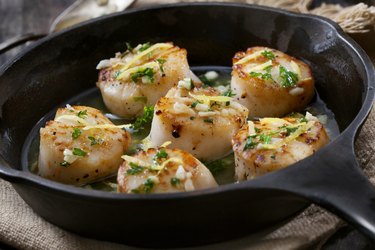
There's no arguing that fish is delish. But when it comes to how seafood might affect the number on the scale, the answer isn't so clear-cut.
While fish can — and should! — be part of a healthy diet, including one geared toward weight loss, serving it the wrong way could end up doing more harm than good. So how much should you be having, what's the best way to cook it and do higher-fat options like salmon or tuna still get the green light?
Video of the Day
Video of the Day
Here are four common seafood mistakes that could be slowing down your weight loss, plus the scale-friendly facts on adding fish and shellfish to your diet.
Mistake 1: Not Eating Enough of It
Nearly half of Americans say they rarely or never eat fish, while a third spring for seafood just once a week, per the Harvard T.H. Chan School of Public Health. But there's no reason to avoid seafood when you're trying to hit a lower number on the scale. In fact, it's one of your best menu options.
Regularly eating fish has been shown to have a positive effect on body weight and thyroid function while reducing the risk for metabolic syndrome, concluded a June 2021 review in [Nutrition and Metabolic Insights](https://journals.sagepub.com/doi/full/10.1177/11786388211022378).
"In general, seafood is low in calories and high in protein, making it a perfect food for someone trying to lose weight while maintaining muscle," explains Frances Largeman-Roth, RDN, nutrition expert and author of Smoothies & Juices: Prevention Healing Kitchen.
A 3-ounce serving of cooked shrimp, for instance, serves up 20 grams of protein for just 84 calories, according to the U.S. Department of Agriculture (USDA). That's nearly as much protein as the same amount of cooked rotisserie chicken breast.
Fix it: Say yes to fish more often. The Dietary Guidelines for Americans recommends 8 or more ounces of seafood per week, whether you're working toward losing weight or not. Choosing a variety of fish and shellfish will give you a wider variety of nutrients (kind of like eating the rainbow, but for seafood!). Just be sure to limit high-mercury fish, recommends the Environmental Protection Agency (EPA). These include king mackerel, marlin, orange roughy, shark, swordfish, bigeye tuna and tilefish from the Gulf of Mexico.
Mistake 2: Slathering It in Butter
Butter might make everything better from a flavor perspective. But smothering your seafood in the golden goo can drastically increase the calorie count of your meal, which could stall your weight loss.
For instance? "While scallops only have 80 calories per 4 ounces, adding 2 tablespoons of butter to the pan while you're cooking them will add an extra 200 calories and 14 grams of saturated fat," Largeman-Roth explains.
Fix it: There's no need to go totally fat-free when you're cooking seafood. But you'll shave off serious calories by trading some of the fat (around 100 calories per tablespoon) for low- or no-calorie flavor boosters like herbs, spices or citrus, according to the American Heart Association (AHA).
And for the fat you do still use, consider swapping the butter for extra-virgin olive oil, Largeman-Roth recommends. The latter contains roughly the same amount of calories as butter, but it's much lower in saturated fat and can help protect against high levels of bad cholesterol and reduce your risk for heart disease, per Harvard Health Publishing.
Mistake 3: Frying It
That crisp, crunchy coating adds a major caloric cost to your meal, Largeman-Roth says. (Along with loads of added sodium, which can leave you feeling puffy and bloated.) Case in point: A 4-ounce fillet of unbreaded cod serves up just 90 calories, but covering it in batter tacks on at least another 200 calories, plus 300 to 400 milligrams of sodium, she notes.
Fix it: It's fine to enjoy battered and fried seafood as a special treat, but make lower-calorie cooking methods your go-to for everyday fish meals, Largeman-Roth recommends. According to the AHA, sautéing, baking, broiling and grilling are all tasty options that can help better support your weight-loss efforts. You can also try an air fryer to avoid the extra oil.
Mistake 4: Being Afraid of Fatty Fish
Think you need to steer clear of omega-3-rich options like salmon, tuna, mackerel or herring when you're trying to lose weight? Think again.
While fatty fish do contain roughly 100 more calories per serving compared to their leaner counterparts, they still deserve a place in your diet, Largeman-Roth notes. Some findings suggest the omega-3 fatty acids found in fatty fish may actually support weight loss, according to a June 2019 review in Nutrition Research Reviews. Plus, "the fat in fatty fish provides protection for our hearts and brains," says Largeman-Roth.
Fix it: Give fish high in omega-3s a regular place on your menu. Just pay attention to your portion size and avoid using large amounts of added fat to cook or flavor your fish, which will help keep the overall calorie count in check. The American Heart Association recommends enjoying a 3-ounce portion of fatty fish at least twice a week.
- Harvard T.H. Chan School of Public Health: "Fish: Friend or Foe?"
- Nutrition and Metabolic Insights: "Fish Consumption: A Review of Its Effects on Metabolic and Hormonal Health"
- U.S. Department of Agriculture: "Crustaceans, shrimp, cooked"
- U.S. Department of Agriculture: "Dietary Guidelines for Americans 2020-2025"
- Environmental Protection Agency: "Guidelines for Eating Fish that Contain Mercury"
- American Heart Association: "Don't fry! Give Healthy Cooking Methods a Try"
- Harvard Health Publishing: "Is extra-virgin olive oil extra healthy?"
- Nutrition Research Reviews: "Seafood intake and the development of obesity, insulin resistance and type 2 diabetes"
- American Heart Association: "Fish and Omega-3 Fatty Acids"
- American Heart Association: "Tis the Seasonings"